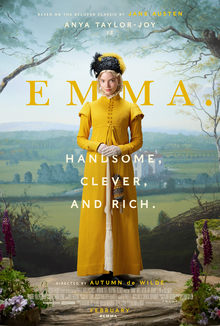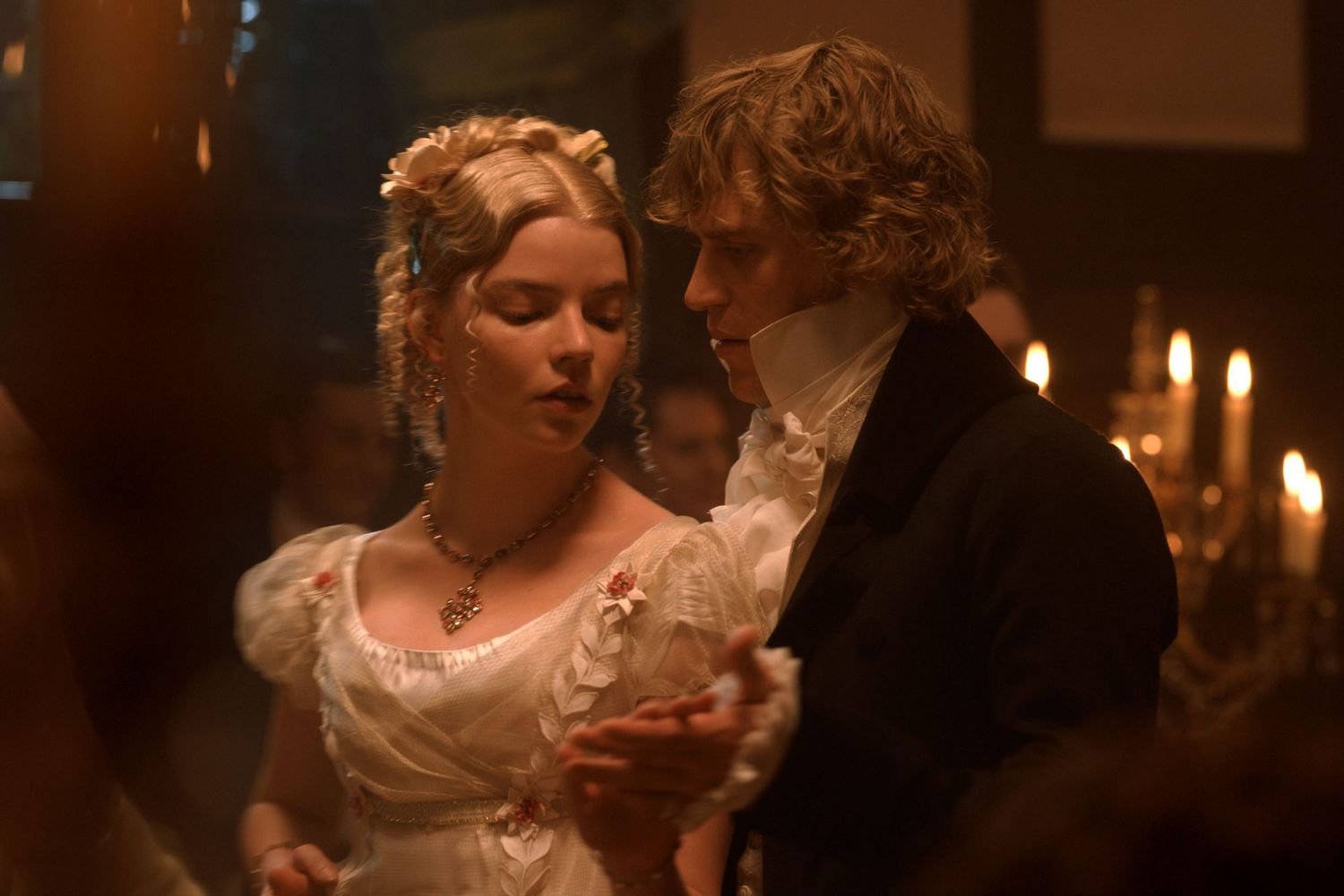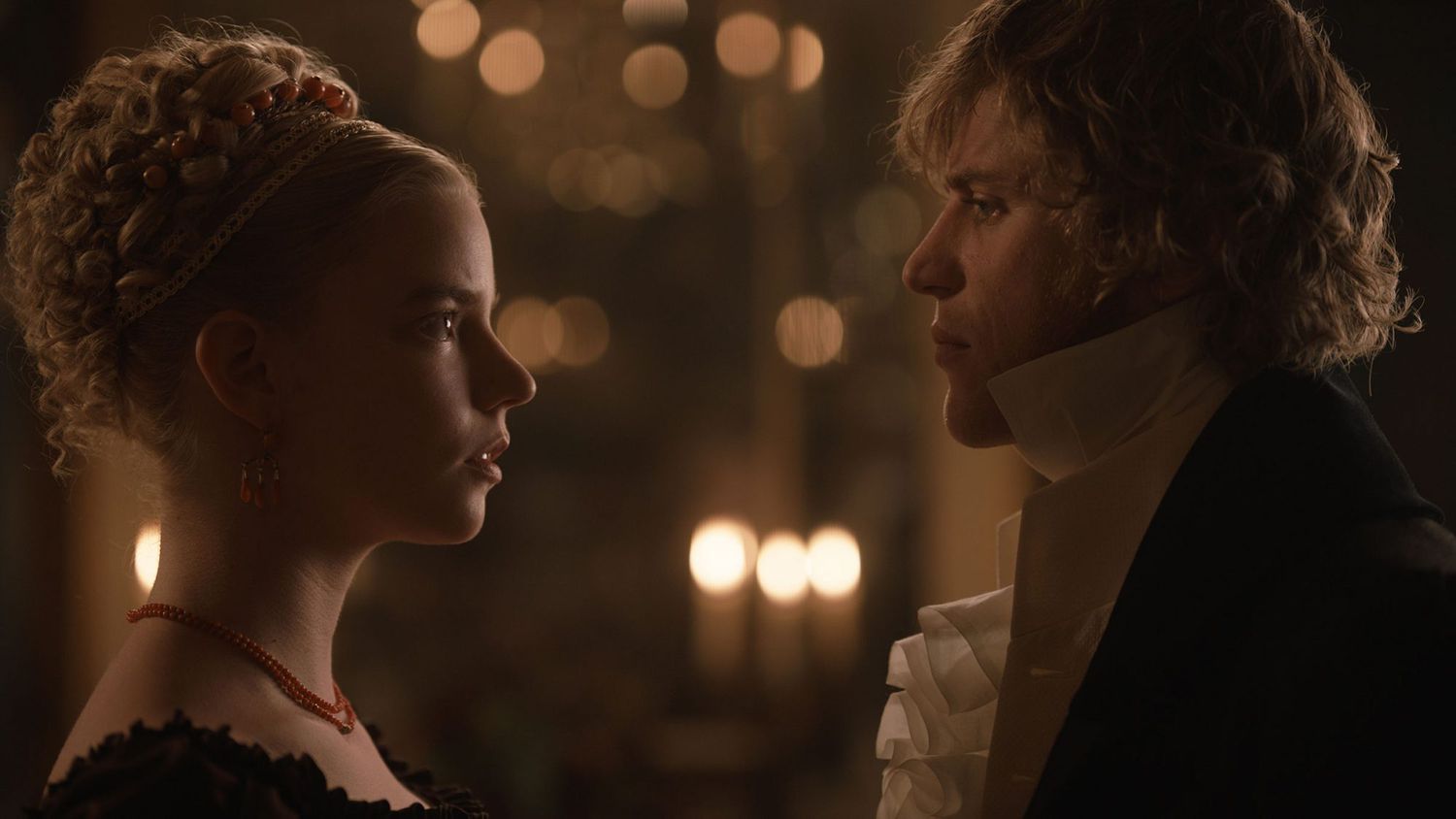
Emma was the last of Jane Austen's novels to be published during her lifetime, and has been described as a comedy of manners. This film took that comedy and heightened it for general audience pleasure -- but the filmmakers didn't leave behind Austen's meaningful commentary. Filmmakers blended choices regarding character, lighting, and costumes to give the audience a most faithful adaptation that aligned with (what we can only guess and analyze) Jane Austen's original purpose. Let's dive right in!
 Right off the bat, we see that Emma is, of course, handsome, clever, and rich. Her handsomeness and her richness are, of course, the easiest of these traits to exaggerate and show on screen. In just the few opening minutes, we see the opulence of Hartfield and the vibrancy of Emma's wardrobe choices. This grand show of the Woodhouse's richness turns it from a position to envy or despise into one the audience can laugh at -- especially when the servants and the Woodhouses go through intense and often unnecessary routines while the characters are still bantering. This show makes it something to laugh at -- hence, filmmakers keep comedic value, while also retaining Austen's commentary about wealth.
Right off the bat, we see that Emma is, of course, handsome, clever, and rich. Her handsomeness and her richness are, of course, the easiest of these traits to exaggerate and show on screen. In just the few opening minutes, we see the opulence of Hartfield and the vibrancy of Emma's wardrobe choices. This grand show of the Woodhouse's richness turns it from a position to envy or despise into one the audience can laugh at -- especially when the servants and the Woodhouses go through intense and often unnecessary routines while the characters are still bantering. This show makes it something to laugh at -- hence, filmmakers keep comedic value, while also retaining Austen's commentary about wealth.  Emma isn't the only character exaggerated for the sake of the scene. The film characters of Harriet, the Eltons, Miss Bates, Jane Fairfax, Frank Churchill, Mr. Knightley, and Mr. Woodhouse are all exaggerations of their bookish counterparts. I found this to be a great way to maintain the comedic nature of the novel, while also staying true to the book. None of these characters are unrecognizable in the ways they are portrayed in the film, and were faithfully cast to the descriptions Austen provided. My favorite had to be Harriet (played by Mia Goth). Her unsophisticated nature, her grand desires, and her unwavering devotion to Emma are all heightened in a way that feels exaggerated, but never over the top. I particularly enjoyed the scene where Emma (played by Anya Taylor-Joy) and Harriet are discussing the original proposal from Robert Martin. In that scene, we can obviously see Harriet's desire to do what she thinks Emma wants her to do -- her wide-open eyes and perfectly-timed hesitation are perfect introductions to her character, and help us immediately understand her motivations early on in the film. Harriet, in the novel, is the subject of Emma's matchmaking attempts throughout Emma, and by the end of the novel, I know I was sympathetic of Harriet and how she never won. Thankfully, in the film, we get some peace of mind about Harriet's happiness with her betrothed Robert Martin. In the book, Harriet is brushed off at the end, in a way that reflects Emma's true and possibly unchanging snobbery, which was an ending I didn't think she deserved. I am so glad we got this little scene of Robert Martin and Harriet together, which the novel did not explicitly provide.
Emma isn't the only character exaggerated for the sake of the scene. The film characters of Harriet, the Eltons, Miss Bates, Jane Fairfax, Frank Churchill, Mr. Knightley, and Mr. Woodhouse are all exaggerations of their bookish counterparts. I found this to be a great way to maintain the comedic nature of the novel, while also staying true to the book. None of these characters are unrecognizable in the ways they are portrayed in the film, and were faithfully cast to the descriptions Austen provided. My favorite had to be Harriet (played by Mia Goth). Her unsophisticated nature, her grand desires, and her unwavering devotion to Emma are all heightened in a way that feels exaggerated, but never over the top. I particularly enjoyed the scene where Emma (played by Anya Taylor-Joy) and Harriet are discussing the original proposal from Robert Martin. In that scene, we can obviously see Harriet's desire to do what she thinks Emma wants her to do -- her wide-open eyes and perfectly-timed hesitation are perfect introductions to her character, and help us immediately understand her motivations early on in the film. Harriet, in the novel, is the subject of Emma's matchmaking attempts throughout Emma, and by the end of the novel, I know I was sympathetic of Harriet and how she never won. Thankfully, in the film, we get some peace of mind about Harriet's happiness with her betrothed Robert Martin. In the book, Harriet is brushed off at the end, in a way that reflects Emma's true and possibly unchanging snobbery, which was an ending I didn't think she deserved. I am so glad we got this little scene of Robert Martin and Harriet together, which the novel did not explicitly provide.
Some other scenes that the novel did not explicitly provide were well-executed and great additions. The scene of Mr. Knightley's dressing, for example, turned the tables for us. Traditionally, we get scenes of women's elaborate and complicated dressing rituals -- this time around, we got an emphasis on a man's elaborate dressing ritual. That was such a great way to even the playing field, as far as our understanding of dressing in the Regency era goes. To continue in this Mr. Knightley vein, the scene where he threw himself down on the floor of the wide room in his mansion where all the furniture is covered, casting aside his extra garments as a way to take out his frustration was another fabulous scene. In fact, I thought it was the funniest scene in the film! In the novel, we often ruminate with Emma on her frustrations, so it was nice to see Mr. Knightley as more than just the object of her frustrations -- it was nice to see that Mr. Knightley was just as frustrated as Emma in these moments of confusion and heartache. Lastly, when Mr. Knightley and Emma finally approach one another about their feelings, an interesting choice was made: Emma has a small nosebleed right after Mr. Knightley professes his true feelings. I thought that was a fun way to sort of break the tension of that moment, and to bring some comedy back in the middle of all the seriousness. While I'm not sure I agree with the addition, I did enjoy the execution of the scene, and the way it demonstrated that each of the characters are truly not as perfect as they want to be.
Emma begins with pretty brusque yet detailed descriptions of each of the characters, and at what points in their lives they have arrived at. The film, though, starts off with Miss Taylor's wedding, which was something that had already happened before the book takes place. You can't exactly show an audience the detailed descriptions without giving them a scene -- so I think the event of Miss Taylor's wedding was the perfect way for filmmakers to describe how and when we're entering Highbury. The wedding scene is a seamless way to incorporate an introduction to most of the main characters and players in Highbury's society. It also provides a great parallel to the end of the movie, and I greatly enjoy beginning and ending parallels, especially in film. The movie itself, though, does actually show the opening lines of the novel before any visual of Hartfield or the wedding -- reminding us all that Austen's work is what inspired the entire film, and that her words still resonate with us today. This is also clear through the flawless use of many of Austen's famous Emma quotes throughout the film. They are well-executed by the actors, and the ones that I wanted to see were all in the movie. To see a list of quotes from Emma (and all of the Jane Austen's other novels!) click here.
Having been in the drama club during high school, I am appreciative of the meaningful ways the filmmakers used lighting and costumes to further their interpretation of Jane Austen's work. The colors are so vibrant, heightening our understanding of the wealth of the Woodhouses, which also further shows the divide between the rich and the poor throughout the movie. The costumes were obviously chosen with care, and the colors always had a meaning -- for example, Harriet's and Mrs. Elton's dresses were both yellow at the ball where Mr. Elton snubbed Harriet out of a dance. That color choice must have been intentional, to draw Mrs. Elton and Harriet together as two "objects" of Mr. Elton's eye, and yet to show one woman was free to dance while the other was not. The costumes also visually enhanced our understanding of the class divides throughout the film, especially in regards to Emma's costumes compared to Harriet's, or Miss Bates's. The lighting was a useful reflection out of what we as viewers should take from a scene: lighter, brighter scenes tended to be funnier, where as scenes with darker lighting carried more weight and had more purpose in furthering the plot. Lastly, the choreography was concise and purposeful -- not only at the ball, but just the complicated dances the servants and the Woodhouses performed at Hartfield. While exaggerated to add humor, this choreography also yet another way to understand Emma's snobbery and her dependency among the people she can't even deign to look at as actual people.
 All in all, the 2020 film adaptation of Emma remained faithful -- the best kind of adaptation any book-lover can hope to find. This film gave us great scenes, while also staying true to Jane Austen's original commentary and purpose with the novel. Some of my favorite scenes included the one where Knightley threw himself to the floor, the ball, and the numerous fights between Mr. Knightley and Emma. If you have a favorite scene or agreeing/conflicting thought with those I presented, please comment below!
All in all, the 2020 film adaptation of Emma remained faithful -- the best kind of adaptation any book-lover can hope to find. This film gave us great scenes, while also staying true to Jane Austen's original commentary and purpose with the novel. Some of my favorite scenes included the one where Knightley threw himself to the floor, the ball, and the numerous fights between Mr. Knightley and Emma. If you have a favorite scene or agreeing/conflicting thought with those I presented, please comment below!  My last thought is this: why did Emma close her eyes right as the film ended? Was she not finally happy, or was she still reluctant to face a future she'd always sworn off? Was she closing her eyes because she couldn't believe she'd find herself at a church dressed in a wedding gown, or because (maybe) she didn't want to be? What, exactly, was her hesitation here? Or, as some might suggest, was she closing her eyes to this fantasy of her life -- the perfection of the colors, textures, and scenes almost too perfect to be any reality an Austen character would have had? If you have any thoughts, I'd love to hear them! I am still quite undecided about this, though I'm glad that a film version of Emma is leaving me with more questions than answers about the heroine Austen herself described as "no one but [herself] will much like."
My last thought is this: why did Emma close her eyes right as the film ended? Was she not finally happy, or was she still reluctant to face a future she'd always sworn off? Was she closing her eyes because she couldn't believe she'd find herself at a church dressed in a wedding gown, or because (maybe) she didn't want to be? What, exactly, was her hesitation here? Or, as some might suggest, was she closing her eyes to this fantasy of her life -- the perfection of the colors, textures, and scenes almost too perfect to be any reality an Austen character would have had? If you have any thoughts, I'd love to hear them! I am still quite undecided about this, though I'm glad that a film version of Emma is leaving me with more questions than answers about the heroine Austen herself described as "no one but [herself] will much like." 


Comments
Post a Comment